Syrian hamster care plays a crucial role in keeping these small pets happy and healthy. Syrian hamsters, also known as golden hamsters, are one of the most popular pet hamster species due to their adorable appearance and friendly nature. Unlike dwarf hamsters, they prefer to live alone and thrive in a well-maintained, enriched environment. Providing the right care ensures they live a long, comfortable life while forming a strong bond with their owners.
Raising a Syrian hamster requires more than just placing it in a cage with food and water. You need to create a proper habitat, offer a balanced diet, and understand their unique behaviors. From selecting the best cage setup to handling them correctly, every aspect of their care impacts their well-being. This guide will give you ten essential tips to help you provide the best possible life for your Syrian hamster. Whether you’re a first-time owner or looking to improve your pet’s care routine, these insights will set you on the right path.
Setting Up the Perfect Syrian Hamster Cage
Choose the Right Cage
Selecting the right cage plays a huge role in your Syrian hamster’s well-being. These small pets need plenty of space to explore, burrow, and exercise. A cage that’s too small can cause stress, boredom, and even health issues. The minimum recommended size for a Syrian hamster cage is 450 square inches of continuous floor space, but bigger is always better.
Opt for a cage with proper ventilation to maintain air quality and prevent moisture buildup. Many owners prefer large glass tanks or bin cages because they offer ample space and prevent bar chewing, a common stress-related behavior. If you choose a wire cage, make sure the bar spacing is no more than ½ inch to prevent escapes. The cage should also have a secure door to keep your hamster safe and contained.
Essential Cage Accessories For the Syrian Hamster
A well-equipped cage keeps your Syrian hamster happy, active, and mentally stimulated. Every cage should include the following essentials:
- Exercise Wheel – Hamsters run several miles per night, so provide a solid-surface wheel (minimum 10-12 inches in diameter) to prevent back issues. Avoid wire or mesh wheels, as they can injure tiny feet.
- Hideouts and Tunnels – Hamsters love to burrow and hide. Add multiple hideouts made of wood or plastic, and create tunnels using hamster tubes or paper towel rolls.
- Chew Toys – A hamster’s teeth grow continuously, so they need wooden chew toys, mineral chews, or cardboard to keep their teeth healthy and prevent overgrowth.
- Food Dish and Water Bottle – Place a sturdy ceramic food dish in the cage and attach a drip-proof water bottle at an accessible height. Some hamsters also enjoy drinking from a small, shallow water bowl.
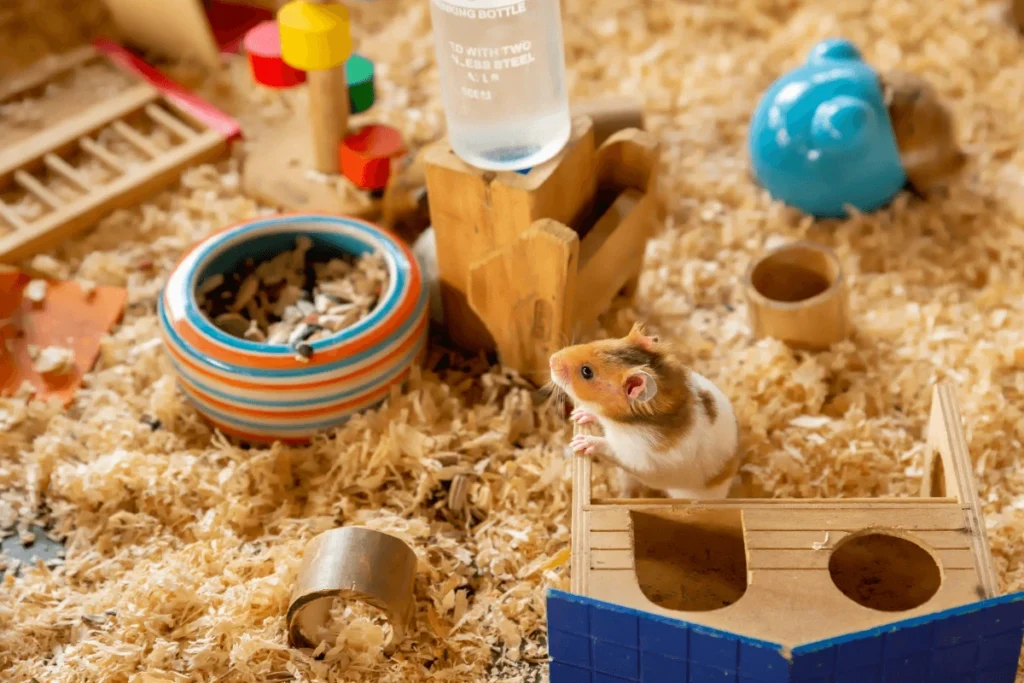
Best Bedding and Substrate Options
Providing the right bedding allows your hamster to burrow, nest, and stay comfortable. Syrian hamsters instinctively dig and tunnel, so they need at least 6-8 inches of bedding to mimic their natural environment.
- Paper-Based Bedding – Soft, dust-free, and absorbent, paper-based bedding is one of the best choices. Brands like Carefresh or Kaytee Clean & Cozy offer safe, comfortable options.
- Aspen Shavings – This is the only safe type of wood shavings for hamsters. Avoid pine and cedar, as they release harmful oils that can damage a hamster’s respiratory system.
- Coconut Fiber or Soil – Some owners mix coconut fiber or sterilized soil into the bedding to encourage natural digging and burrowing.
- Bedding to Avoid – Never use cotton fluff or scented bedding, as they can cause blockages if swallowed and may lead to respiratory problems.
By setting up a proper cage with the right accessories and bedding, you create a stress-free and enriching environment where your Syrian hamster can thrive.
Providing a Nutritious Diet for Your Syrian Hamster
A well-balanced diet plays a key role in your Syrian hamster’s overall health, lifespan, and energy levels. These small pets need a combination of high-quality pellets, a variety of seeds, fresh vegetables, and occasional treats to thrive. Offering the right food ensures they receive essential nutrients while maintaining an active and happy lifestyle.
High-Quality Pellets and Seed Mix
Feeding your Syrian hamster the right base diet prevents health issues and supports steady growth. Pellets should make up the majority of their diet because they provide a consistent balance of nutrients. Unlike seed mixes, pellets prevent selective eating, which happens when hamsters pick out their favorite seeds and ignore the rest. This behavior leads to nutritional imbalances, so choosing a high-quality pellet ensures your hamster gets all the essential vitamins and minerals they need.
When selecting a pellet brand, check the ingredients list. Look for natural, whole-food ingredients without artificial colors, flavors, or preservatives. Avoid hamster foods that contain excessive fillers like corn, wheat, or soy, as these provide little nutritional value.
In addition to pellets, a varied seed mix helps mimic the natural diet of wild hamsters. A good mix should contain:
- Sunflower seeds – A great source of healthy fats (but should be fed in moderation).
- Flaxseeds – Provide omega-3 fatty acids for healthy skin and fur.
- Pumpkin seeds – Rich in protein and essential minerals.
- Dried mealworms – Offer a good protein boost.
- Whole grains like oats, barley, and millet – Supply fiber for good digestion.
Avoid seed mixes that contain too many peanuts, sunflower seeds, or sugary dried fruits, as these can lead to obesity if fed in large amounts. Mixing pellets and seeds ensures a nutrient-rich, balanced diet while encouraging natural foraging behaviors.
Fresh Vegetables and Treats For Syrian Hamster
Fresh vegetables provide vitamins, minerals, and fiber, keeping your hamster’s digestive system healthy. Offer fresh vegetables 3-4 times per week in small amounts to prevent stomach upset.
Here are some safe vegetables for Syrian hamsters:
- Leafy greens (romaine lettuce, spinach, kale – in small amounts)
- Bell peppers (all colors)
- Carrots (feed occasionally due to their sugar content)
- Cucumber (great for hydration)
- Broccoli and cauliflower (nutritious but should be given in moderation)
- Zucchini and squash (mild and easy to digest)
Fruits should be given sparingly because they contain natural sugars that can contribute to weight gain. Safe fruit options include:
- Apple (without seeds)
- Banana (tiny pieces only)
- Blueberries, raspberries, or blackberries
- Strawberries (in moderation)
Always wash all vegetables and fruits before feeding to remove pesticides and harmful chemicals. Introduce new foods slowly to make sure they don’t cause digestive issues.
Choosing the Right Treats
Treats help build trust between you and your hamster, making them an excellent tool for taming and bonding. However, too many treats can lead to obesity, diabetes, and poor eating habits, so feed them in small amounts and choose natural options over processed pet-store treats.
Healthy treat options include:
- Plain, unsalted nuts (almonds, walnuts, peanuts – only in very small amounts).
- Dried herbs (such as chamomile, dandelion, or parsley).
- Small portions of whole grains (plain cooked oats or brown rice).
- Cheerios (only plain, unsweetened ones).
Avoid chocolate, processed sugars, salty snacks, dairy products, and citrus fruits, as they can cause serious health issues for hamsters.
Hydration Matters
Proper hydration is just as important as a healthy diet. Your hamster needs fresh, clean water available at all times to stay healthy. A drip-proof water bottle works best because it keeps the water clean and prevents spills. Make sure to:
- Check the water bottle daily to ensure it isn’t clogged or leaking.
- Refill it with fresh water every day to avoid bacteria buildup.
- Place the nozzle at the right height so your hamster can drink comfortably.
Some hamsters prefer drinking from a small, shallow water bowl, but this method requires frequent cleaning since bedding and food can easily contaminate the water. If you use a bowl, change the water at least twice a day to keep it fresh.
A well-rounded diet combined with proper hydration ensures your Syrian hamster stays energetic, maintains a healthy weight, and lives a long, happy life. By offering a variety of nutrient-rich foods and keeping their water clean, you set the foundation for excellent health and well-being.
Understanding Syrian Hamster Behavior and Handling
Syrian hamsters have unique personalities and behaviors that owners need to understand to create a positive and enriching environment. Their nocturnal nature, need for gentle taming, and the ability to recognize stress or happiness all play a crucial role in their well-being. Learning how they communicate and interact with their surroundings will help you develop a strong bond with your pet.
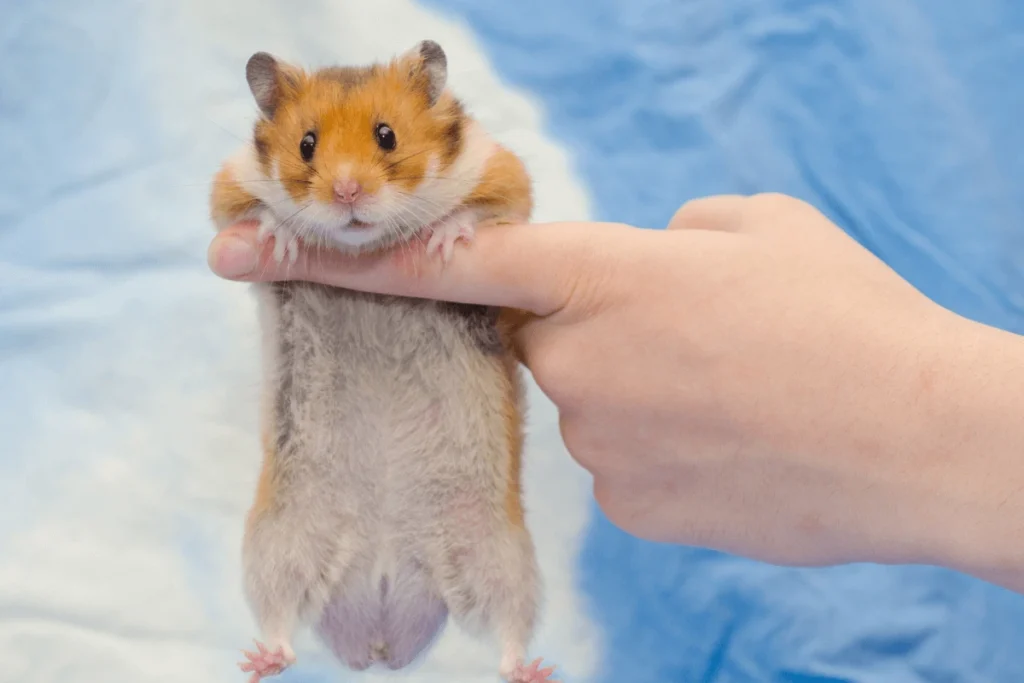
Nocturnal Nature
Syrian hamsters are nocturnal, meaning they sleep during the day and become active at night. In the wild, this behavior helps them avoid predators and search for food safely after dark. As a pet owner, you should respect their sleep schedule and avoid disturbing them during daylight hours.
If you wake your hamster up abruptly, it might feel startled or stressed, which could lead to defensive behaviors like biting or hiding. Instead of forcing interaction, allow your hamster to wake up naturally in the evening. The best time for handling and playtime usually falls between 7 PM and midnight, when your hamster feels most energetic.
To accommodate their nighttime activity, place their cage in a quiet area where daytime disturbances won’t interrupt their sleep. If you are a light sleeper, avoid keeping the cage in your bedroom because activities like running on the wheel or chewing on toys might disturb you.
Taming and Socialization
Building trust with a Syrian hamster takes time, patience, and consistency. Unlike some other small pets, hamsters rely on scent and sound rather than sight, so they need time to recognize your smell and voice.
Follow these steps to tame and socialize your hamster:
- Let Your Hamster Adjust – When you bring a new Syrian hamster home, allow it to settle into its cage for a few days before attempting to handle it. Let it explore and get used to your presence.
- Use Your Voice – Talk softly near the cage so your hamster associates your voice with safety. Avoid loud noises, sudden movements, or hovering over the cage, as this can feel threatening.
- Offer Treats from Your Hand – Slowly introduce your scent by placing a small treat (like a sunflower seed) in your palm and letting your hamster approach you. Never force interaction—allow them to come to you at their own pace.
- Use a Cupping Motion to Pick Them Up – Once your hamster feels comfortable taking treats from your hand, gently scoop it up using both hands in a cupped position. Never grab from above, as this mimics predator behavior and can cause fear.
- Short, Positive Interactions – Handle your hamster for a few minutes at a time, gradually increasing the duration as they grow more comfortable with you.
Each hamster tames at its own pace, so stay patient and avoid rushing the process. If your hamster seems scared, take a step back and try again later.
Signs of Stress and Happiness
Understanding your hamster’s body language helps you recognize when they feel comfortable or when something is wrong. Watch for both positive and negative behaviors to ensure they stay happy and stress-free.
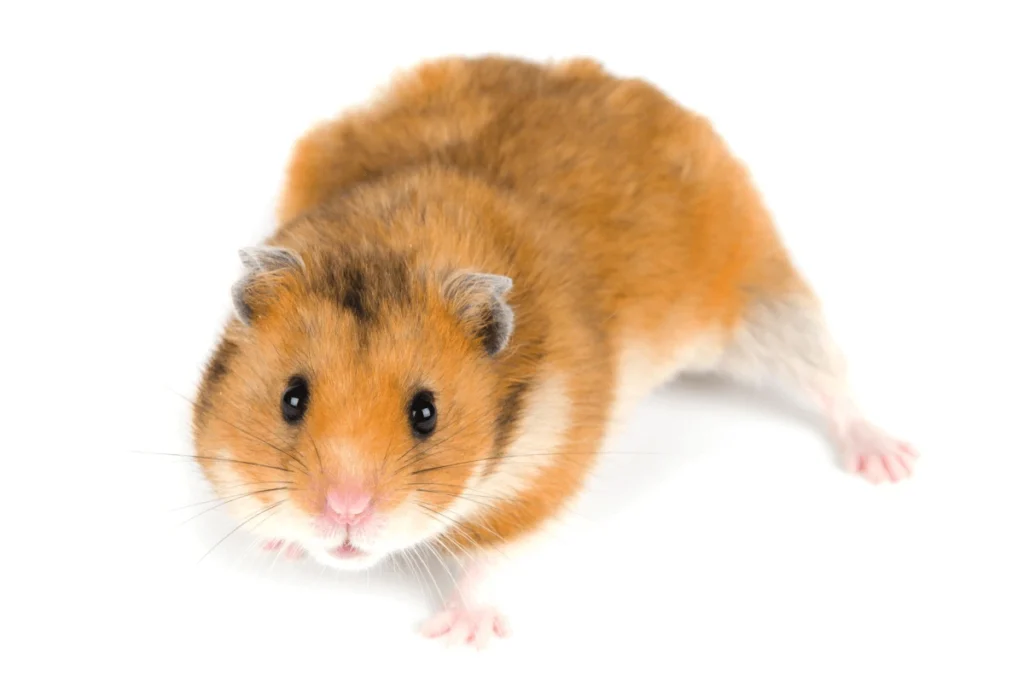
Signs of a Happy Syrian Hamster:
- Active and Curious – A happy hamster explores its cage, uses tunnels, and runs on its exercise wheel.
- Eager to Interact – If your hamster willingly approaches you or climbs onto your hand, this shows it trusts you.
- Grooming and Stretching – Regular self-grooming indicates that your hamster feels safe and relaxed. Stretching or yawning also shows contentment.
- Pouching Food and Nesting – A hamster that gathers food and builds a cozy nest feels secure in its environment.
Signs of Stress or Unhappiness:
- Hiding Excessively – While hamsters love hideouts, a hamster that rarely comes out may feel unsafe or stressed.
- Teeth Chattering or Squeaking – These sounds indicate nervousness or irritation. If your hamster chatters its teeth when you approach, it might feel threatened.
- Biting the Cage Bars – This behavior, known as bar chewing, often means the cage is too small or lacks enrichment. Provide more toys, chews, and a larger living space.
- Flattening Their Body – A hamster that presses itself to the ground and stays motionless feels scared or overwhelmed.
- Sudden Aggression or Biting – If your usually friendly hamster starts biting, check for stressors, such as loud noises, improper handling, or health issues.
By observing these behaviors and adjusting their environment or handling approach, you can ensure your Syrian hamster feels secure, comfortable, and happy in your care.
Keeping Your Syrian Hamster Healthy
Providing proper healthcare ensures that your Syrian hamster stays active, comfortable, and happy throughout its life. Like all pets, hamsters can develop health problems, so recognizing early warning signs, maintaining proper hygiene, and knowing when to visit a vet can significantly improve their quality of life.
Common Health Issues
Syrian hamsters are generally hardy pets, but they can suffer from various health problems, especially if their diet, cage conditions, or hygiene are inadequate. Here are some of the most common health issues to watch for:
1. Wet Tail
Symptoms: Severe diarrhea, wet and matted fur around the tail, loss of appetite, lethargy.
Causes: Stress, poor diet, dirty cage, overcrowding.
Treatment: Wet tail is a life-threatening condition and requires immediate veterinary attention. Hamsters with wet tail often need antibiotics and supportive care.
2. Respiratory Infections
Symptoms: Sneezing, wheezing, labored breathing, runny nose, watery eyes.
Causes: Cold drafts, damp bedding, dusty or scented substrates, exposure to sick pets.
Treatment: Move your hamster to a warm, dry environment and seek vet care if breathing problems persist.
3. Mites and Skin Irritations
Symptoms: Constant itching, hair loss, red or flaky skin.
Causes: Dirty bedding, stress, poor diet, allergies.
Treatment: A vet can prescribe specialized mite treatments. Keeping the cage clean and providing a balanced diet helps prevent skin issues.
4. Overgrown Teeth
Symptoms: Difficulty eating, drooling, weight loss.
Causes: Lack of chew toys, improper diet.
Treatment: Provide wooden chew toys and hard foods like nuts or whole grains. If the teeth grow too long, a vet may need to trim them.
5. Tumors and Lumps
Symptoms: Swelling under the skin, difficulty moving, changes in appetite.
Causes: Genetic predisposition, aging.
Treatment: A vet should examine any unusual lumps to determine if surgery or medication is necessary.
Regularly observing your hamster’s behavior and physical condition helps you detect these health issues early, allowing for quicker treatment and a better chance of recovery.
Hygiene and Grooming
Hamsters are naturally clean animals that groom themselves regularly, but they still need a clean living environment to stay healthy. Unlike other pets, Syrian hamsters should never be bathed in water, as this can strip their fur of essential oils and cause stress or illness.
Cage Cleaning Routine:
- Spot Clean Daily: Remove soiled bedding, uneaten food, and waste.
- Deep Clean Weekly: Replace all bedding, wash the cage and accessories with pet-safe soap, and dry everything completely before refilling.
- Avoid Strong Chemicals: Never use bleach or scented cleaners, as the fumes can irritate your hamster’s respiratory system.
Grooming Needs:
- Sand Baths: Instead of water baths, provide a bowl of chinchilla sand (not dust) so your hamster can roll in it to remove excess oils and dirt.
- Fur Care: Long-haired Syrian hamsters may need occasional brushing with a soft toothbrush to prevent tangles.
- Nail Trimming: If your hamster’s nails become too long and start curling, a vet can trim them safely.
Keeping your hamster’s cage clean and providing proper grooming materials ensures they remain comfortable and free from infections.
When to Visit a Vet
Even with excellent care, Syrian hamsters may require veterinary attention at some point in their lives. Because hamsters hide their illnesses until they become severe, it’s important to recognize signs that require professional help.
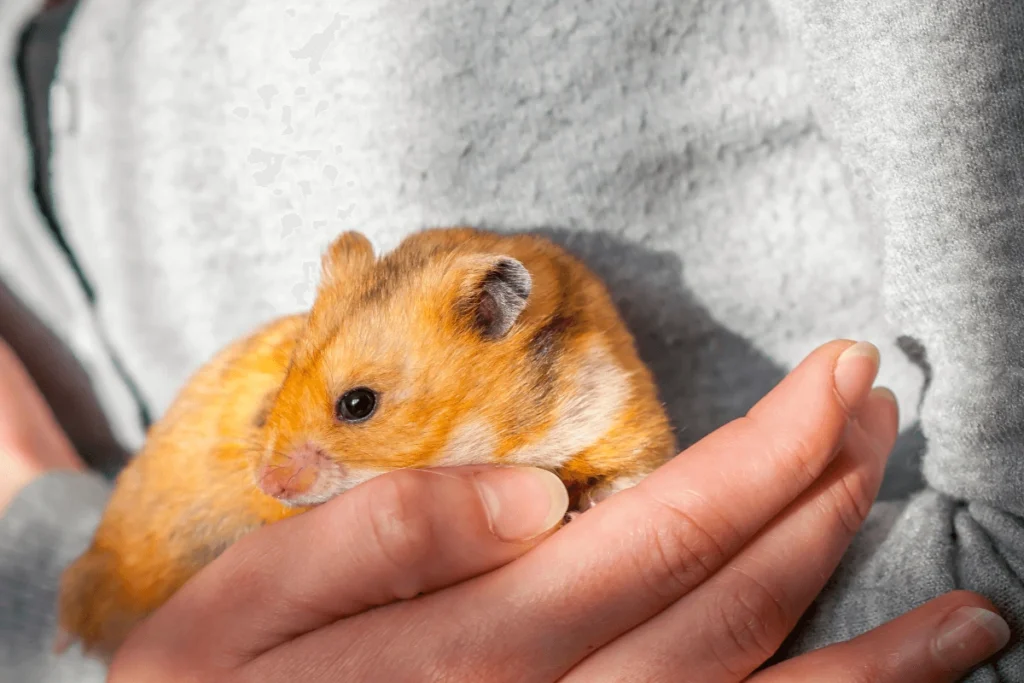
Reasons to Take Your Hamster to the Vet:
- Sudden weight loss or lack of appetite
- Lethargy or unusual inactivity
- Breathing difficulties (wheezing, rapid breathing, nasal discharge)
- Severe diarrhea (possible wet tail) or constipation
- Open wounds, abscesses, or excessive scratching
- Overgrown teeth or difficulty eating
- Lumps or unusual swelling
If you notice any of these symptoms, do not wait—hamsters have fast metabolisms, and their health can decline rapidly. Find an exotic pet veterinarian who specializes in small animals to ensure your hamster receives proper care.
By maintaining good hygiene, providing a nutritious diet, and watching for early signs of illness, you can keep your Syrian hamster happy and healthy for years to come.
Enriching Your Hamster’s Life with Fun Accessories
Syrian hamsters are intelligent and active animals that need plenty of mental and physical stimulation to stay happy. In the wild, they spend their nights running, burrowing, and foraging, so they need a variety of toys, tunnels, and hideouts in their cage to mimic this natural behavior. A well-enriched habitat prevents boredom, reduces stress, and encourages natural instincts, which leads to a healthier and more content pet.
Toys and Chew Toys
Hamsters have constantly growing teeth, so they need safe and effective chew toys to keep their teeth at a healthy length. Without enough chewing opportunities, their teeth can become overgrown, leading to eating difficulties and health issues.
Best Chew Toys for Syrian Hamsters:
- Wooden Chew Blocks: Natural, untreated wood helps file down teeth while providing entertainment. Avoid cedar or pine, as these can release harmful oils.
- Willow or Applewood Sticks: These safe wood options offer a satisfying texture for gnawing.
- Compressed Hay or Alfalfa Blocks: These provide both chewing exercise and a small nutritional boost.
- Pumice Stones: A natural alternative to wood that helps maintain dental health.
- Cardboard Tubes: Empty toilet paper or paper towel rolls offer a simple and inexpensive chewing and play option.
In addition to chew toys, Syrian hamsters enjoy interactive toys that encourage exploration. Adding hanging bridges, climbing structures, or small wooden platforms makes their environment more engaging and stimulating.
Exercise Wheels and Tunnels
Hamsters are natural runners and can travel miles in a single night in the wild. Providing the right exercise wheel allows them to satisfy this instinct without risk of injury.
Choosing the Best Exercise Wheel:
- Size Matters: Syrian hamsters need a minimum wheel diameter of 10-12 inches (25-30 cm) to prevent back strain.
- Solid Surface: Opt for a wheel with a solid running surface rather than bars or wire rungs, as these can cause foot injuries or entrapment.
- Quiet Spinning: Some wheels are noisy, especially at night. Look for ball-bearing or silent wheels to reduce disruptions.
Without a proper wheel, hamsters may develop frustration, boredom, or even obesity due to lack of exercise. If your hamster avoids using its wheel, it may be too small or uncomfortable, so consider upgrading to a larger and sturdier model.
Tunnels for Exploration and Play
Syrian hamsters are burrowing animals, so tunnels allow them to mimic their natural underground lifestyle. Adding tunnels to their cage creates a sense of security, encourages exercise, and prevents boredom.
Best Tunnel Options for Syrian Hamsters:
- Plastic Play Tubes: Many hamster cages come with attachable tubes, but be sure they are large enough for a Syrian hamster’s size. Some store-bought tubes are too narrow, which can cause discomfort.
- Cardboard Tunnels: Simple, safe, and inexpensive! They can also be replaced easily when chewed up.
- Wooden or Cork Tunnels: These provide a natural aesthetic while being sturdy and safe for chewing.
- DIY Digging Tunnels: A deep layer of bedding (at least 6 inches) allows your hamster to create its own tunnels, which adds natural enrichment to its environment.
By offering both exercise wheels and tunnels, you create an environment that encourages natural movement and exploration, reducing stress and improving overall well-being.
Hideouts and Nesting Materials That Syrian Hamster Likes
Hamsters need a private, enclosed space to sleep, rest, and feel safe. In the wild, they dig underground burrows to protect themselves from predators and regulate their body temperature. Providing the right hideouts and nesting materials ensures that your Syrian hamster feels secure in its habitat.
Best Hideout Options:
- Wooden Hideouts: Natural wood houses provide chewable, cozy sleeping spaces that mimic real burrows.
- Ceramic or Clay Hideouts: These stay cool in warm temperatures and provide a sturdy, chew-resistant hiding spot.
- Coconut Shell Hideouts: A fun and natural alternative that also serves as a chewable toy.
- Multi-Chamber Hideouts: These mimic underground burrows with separate rooms for sleeping and food storage.
Choosing Safe Nesting Materials:
A hamster’s nest serves as a soft, warm sleeping area where they can curl up and feel protected. The best nesting materials should be safe, natural, and digestible in case your hamster chews on them.
Safe Nesting Materials:
- Plain, Unscented Paper Bedding: Soft, absorbent, and comfortable for nesting.
- Shredded Toilet Paper or Paper Towels: A cost-effective and safe option.
- Hay or Dried Grass: Adds a natural touch and provides mild chewing enrichment.
Unsafe Nesting Materials to Avoid:
- Cotton or Fluffy Bedding: This can cause choking hazards and intestinal blockages if ingested.
- Scented Bedding: Artificial fragrances can irritate a hamster’s sensitive respiratory system.
- Synthetic Fabrics or Fibers: These may tangle around their feet, leading to injuries.
Providing the right hideouts and nesting materials allows your hamster to feel safe and comfortable, which helps reduce stress and encourage natural burrowing behaviors.
By incorporating toys, exercise wheels, tunnels, and hideouts into your Syrian hamster’s cage, you create a dynamic environment that keeps them entertained, active, and stress-free. Hamsters thrive when they have opportunities to run, chew, explore, and nest, so offering a variety of enrichment options will ensure they stay happy and engaged.
Conclusion
Caring for a Syrian hamster goes beyond providing food and a cage—it requires understanding their unique needs, offering proper enrichment, and ensuring their health and happiness. These small pets thrive in environments that allow them to express natural behaviors, such as burrowing, running, chewing, and exploring.
Setting up a spacious and well-equipped cage gives your hamster a secure home where they feel comfortable. A proper diet that includes high-quality pellets, seeds, fresh vegetables, and occasional treats keeps them healthy and energetic. Since Syrian hamsters are nocturnal, respecting their natural schedule and handling them gently helps build trust and strengthens your bond.
Providing essential accessories like chew toys, tunnels, exercise wheels, and hideouts ensures they stay active and mentally stimulated. A well-enriched habitat prevents boredom and stress, reducing negative behaviors like bar chewing or excessive hiding. Keeping their cage clean, maintaining good hygiene, and monitoring for signs of illness will help your hamster live a long and healthy life.
By recognizing the signs of stress and happiness, you can respond to your hamster’s needs and create a safe, loving environment. If you notice any health concerns, seeking prompt veterinary care can prevent small issues from becoming serious problems.
Syrian hamsters may be small, but they have big personalities and unique needs. When given proper care, they become loving and interactive pets that bring joy to their owners. Whether you’re a new hamster parent or an experienced owner, focusing on enrichment, nutrition, health, and socialization will ensure your furry friend lives a happy and fulfilling life.
What’s The 5 Best Syrian Hamster Colors? Find Out Here
Find The Best Name For your Lovely Hamster from our Top 100 Names HERE!
Read More about Furry Pets From HERE!
Find Good stuff for your Tiny Pets On Pet MD Official
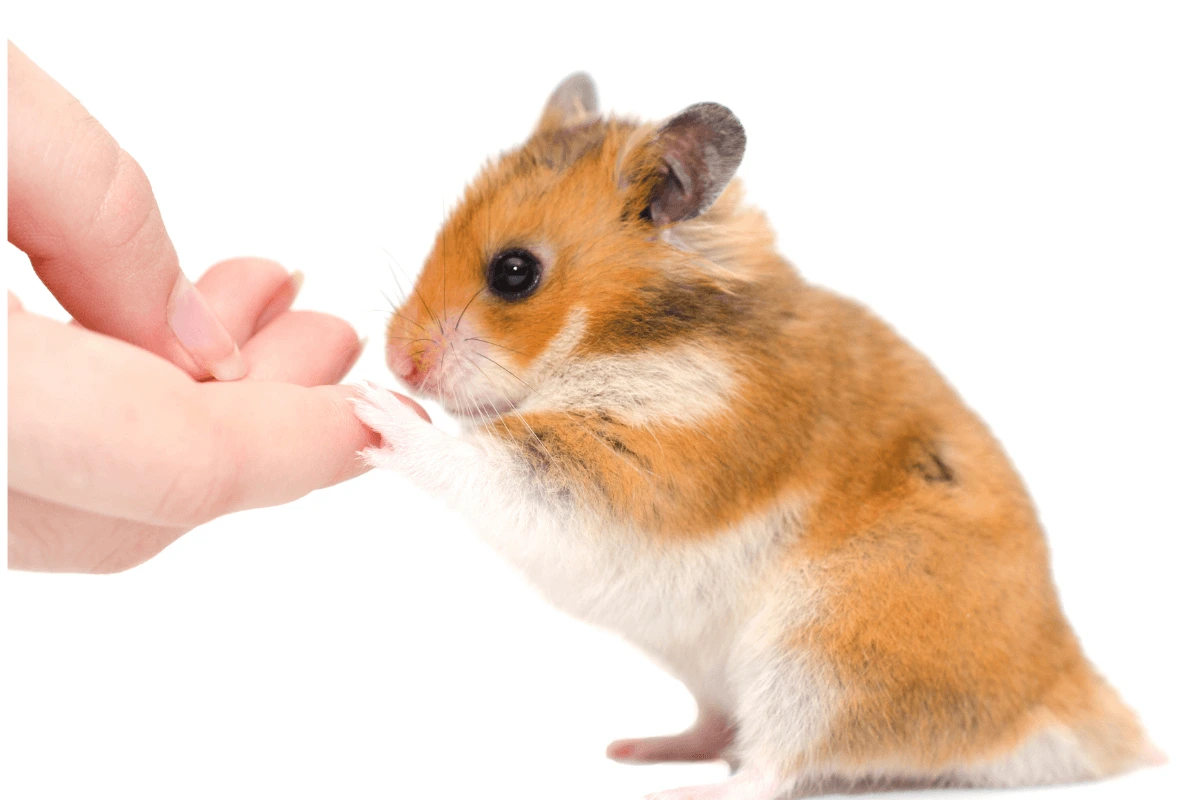
4 thoughts on “Syrian Hamster Care: 10 Tips You Need to know for a happy pet”
Comments are closed.